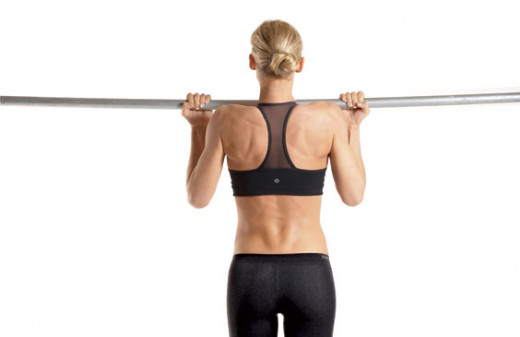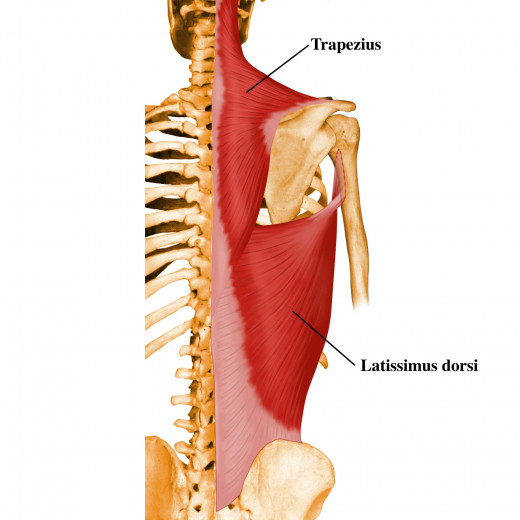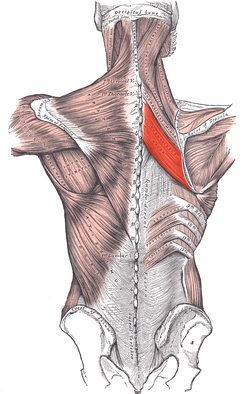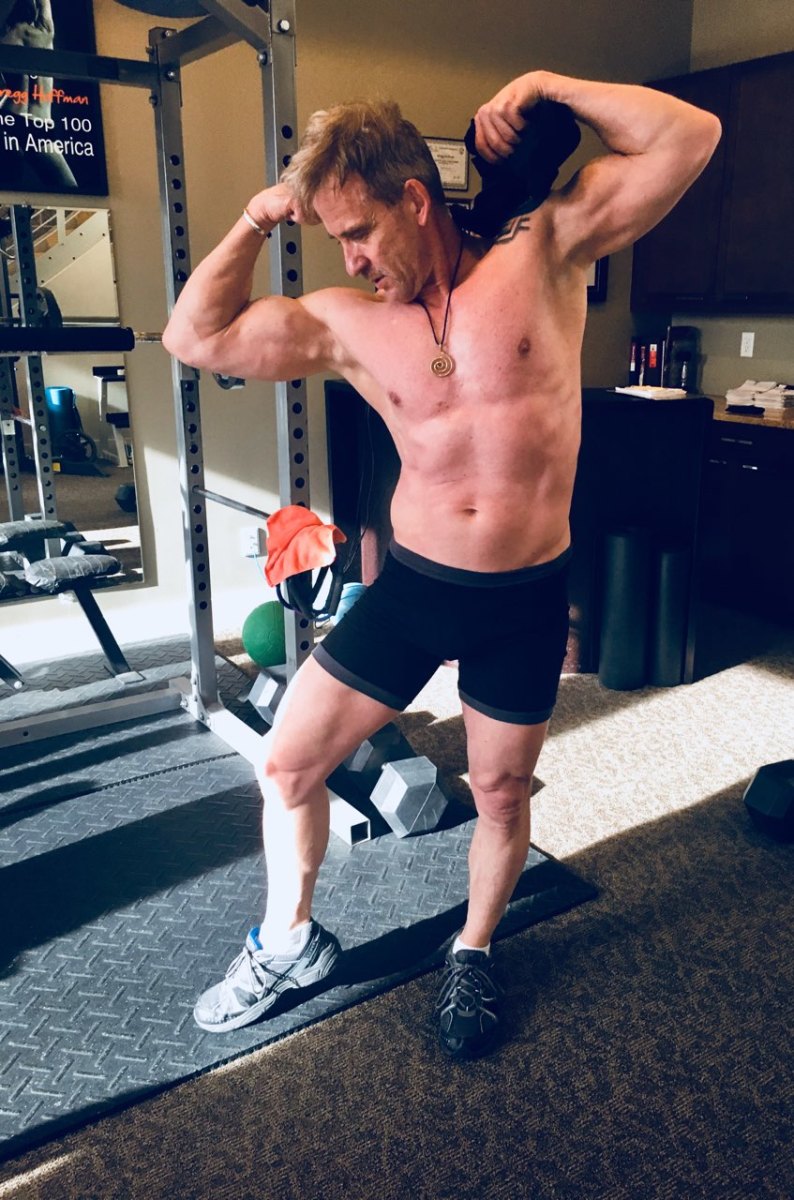How To Do Pull Ups

What are pull ups and why should I do them?
A pull up is a back-strengthening exercise in which you begin by gripping a horizontal bar above head height with both hands, let yourself hang suspended with your arms at full extension, pull yourself up vertically until your chin is above the bar, and then lower yourself down to hanging.
Pull ups are simple to do and need almost no equipment. They're also an important part of any well-rounded strength training program, not to mention one of the best ways to keep your back healthy, strong, and free of injury.
The latissimus dorsi and trapezius

The rhomboids

Why do pull ups?
First of all, pull ups are one of the best back strengtheners out there. Just about every muscle in your back participates in a pull up.
Better yet, pull ups build functional strength. Functional strength training prepares your muscles to perform everyday activities. Pull ups will make it easier for you to pick up that twenty pound bag of dog food, shovel snow out of your driveway, wrestle that heavy suitcase off the conveyor belt at the airport, and do it all with a much lower risk of hurting yourself, since you now have strong, resilient back muscles to do that all with.
Pull ups are also easy to learn and can be done with little to no special equipment. Pull up bars are helpful, but even a sturdy door or a set of monkey bars will do.
Finally, pull ups are a compound exercise. Compound exercises work multiple muscle groups at once. This not only makes for a more efficient workout, but it also makes for a more effective fat burning workout. The reason for that is simple: Muscles need calories to work, and the more muscles you use, the more calories you’ll burn.
What muscles do pull ups target?
The key to a pull up’s effectiveness lies in the muscles it recruits. As a matter of fact, a pull-up, properly done, uses every major muscle group in the back, plus a few in the core and the arms.
Here’s a brief list of the major players in a pull up:
- Latissimus dorsi: More commonly known as your lats, these two winglike muscles cover most of your back and are responsible for most of the heavy lifting in a pull up.
- Rhomboids: These muscles are responsible for the movement of your shoulder blades. What we’re interested in here is the rhomboids’ ability to contract the shoulder blades back and in to facilitate lifting and pulling motions, including those involved in a pull up.
- Trapezius: These muscles are most heavily involved in shrugging and pressing motions. However, the lower fibers become engaged in pull ups, pulldowns, and in many lifting motions.
Other muscles involved in pull ups are the biceps (especially during chin ups), the abdominals, and the erector spinae. The latter are the muscles along the lumbar spine which stabilize the low back.
As you can see from the facing pictures, there are a significant number of big muscle fibers involved in pull ups - and quite a few minor. This is the secret to the pull up's effectiveness.
What do I need to do pull ups?
You don’t need much equipment to do pull ups, but you do need something to pull yourself up with! That’s where pull up bars come in.
Here are a few of the more common types of pull up bars:
Door pull up bar
This is the cheapest, most common type of pull up bar. They're much sturdier than they seem, and most of them are rated up to 200lbs, but always check the weight limits before buying.
Wall mounted pull up bar
These can hold more weight than doorway pull up bars. However, they’ll only work as long as you don’t mind drilling holes in your wall. Remember to mount this bar to the studs, not to the drywall.
Rafter mounted
This kind of bar is the sturdiest of them all, and works best for those who work out in their basement. Just make sure that you leave enough clearance above the bar so that you’re not hitting your head on the ceiling every time you pull yourself up. Concussions don’t build muscle.
Monkey bars!
If you have a playground near your house and aren’t on the local sex offender registry, you could always go play on the monkey bars. It’s free, and it lets you do your pull ups out in the fresh air.
Your bedroom door
While this is not an ideal option, it’ll work in a pinch. Prop the door open with a door stop, pad the upper edge with a towel, grab it, and start doing pull ups. You won't be able to avoid brushing against the door, but for a beginner this is a cheap and easy alternative.
Power tower
This is a more expensive option and requires a little more space, since it's basically a pull up bar on its own steel frame. However, it is a great option for those who want to splurge, since it offers a nice, sturdy bar to do pull up bars with no risk of hitting your head on the ceiling or having the bar fall down. Very often pull up stations will also include accessories, like a dip station. Look for one which has a strong, stable footing, doesn’t wobble when you hang your weight off of it, and has a bar which offers a secure but comfortable grip. Things like a dip station or handgrips to do parallel grip pull ups are a plus.
Other types of pull ups
Standard pullups aren't your only option. Here are a few variations.
Chin ups
Chin ups are much easier for beginners, since they let you use your arm strength in addition to your back strength. To do these, simply bring your hands in to slightly less than shoulder width apart and grip the bar with your palms facing you.
Negative pull ups
A negative pull up is basically the second half of a full pull up – the lowering down part. To get yourself up to the bar, you can jump or step up instead of pulling yourself up. Then you lower yourself slowly over a count of ten. These are great training exercise for beginners, since they're the same motion as a pull up and train the same muscles, only they eliminate the hardest part of the exercise. Once you can do 12 to 15 of these, you can probably start doing normal pull ups.
L sit pull ups
This is a great variation for the abs. Do a standard pull up or chin up, only before you begin, straighten your legs and lift them in front of you until they're parallel to the floor and at a 90 degree angle to your torso. Hold this position as you do your pullups.
Towel pull ups
Another fun and challenging variation, this trains forearm and grip strength as well as forcing you to work harder to stabilize yourself. Just loop a towel over the bar, grip one end in each hand, and pull yourself up by the towel. Obviously you don't want to be using a threadbare old tea towel for this. You can also do the same thing with a rope, as long as you have a knot of some kind at the ends to keep your hands from slipping.
Body weight row
This is another alternative to pull ups for those who aren’t quite ready for primetime. To do it, lay a barbell or a sturdy metal or wooden pole across two equally sturdy chairs. Position yourself beneath the pole, grip it about shoulder width apart, and pull yourself up towards it. You want the pole to end up against your chest. Lower yourself back to the ground and repeat. You can also do the same motion while gripping the edge of a table, if the pole isn’t available.
However, make sure that whatever furniture you choose to do these with, it’s strong, stable, and will not tip over or break.
Kipping pull ups
Do not do these. Ever.
I know, I know, Crossfitters the world over love these. However, kipping pull ups are a great way to get hurt, since they're not so much a pull up as they are an exercise where you jump up to the bar and sort of twist and fling yourself the rest of the way up. The motion is too uncontrolled, and it's too easy to swing just a little too hard or in just the wrong way and end up wrenching something you really shouldn't.
How do I do pull ups?
As with any exercise, how much you get from the exercise depends on how good your form is. Fortunately, while doing perfect pull ups can be tricky, doing good pull ups isn’t hard at all.
When doing pull ups, always keep a sturdy chair or stool just beneath you. If your bar is high enough, you’ll need a chair to reach it in any case, and if you need a little extra help to get up or you need to let go of the bar suddenly, you’ll be glad that chair is there.
Some key aspects of good pull up form:
- Grip the bar with your hands at shoulder width, palms away from you. This is called standard pull up position, and helps ensure that all of the muscles you want to be used will be used.
- Keep your wrists neutral. This reduces strain on your wrists, forearms, and elbows.
- Keep your shoulders back and shoulder blades pinched in towards your spine. This keeps your back muscles engaged so that they can do most of the work, rather than letting your arms do it.
- Don’t swing. I'm serious about this. If you swing, you’re using momentum to pull you up, not your own muscles. Your muscles are never going to get stronger if you don't use them.
But I'm a woman - women can't do pull ups!
That's bull.
Plenty of women can do pull ups. All it takes is training, persistence, and ignoring everybody who tells you, "Girls can't do that."
Think about it. Girls are told we can't be good at driving, either. Or math. Or particle physics. Or any number of things, really.
That's bull.
Don't believe me? Watch the video to the right.
Being a woman isn't a reason not to do pull ups. It's an excuse.
So what if they say girls can't be strong?
Do a pull up. Prove them wrong.








